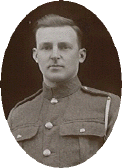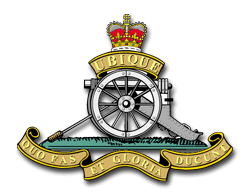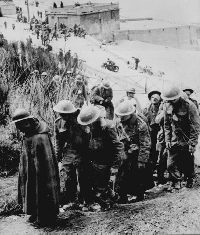John
Parsons | Phyllis Knight
| Harry Knight |
Fred
Knight | William
James Knight
David
Thomas Parsons | The
Butler family
 John Parsons
John Parsons


John Parsons was born in the parish of Chipping Norton in
Oxfordshire on 28th of September 1904. His father was Arthur Thomas Parsons, his mother was Sarah Anne Parsons (A Boscott by birth). He had two sisters (Mary
and Agnes) and a brother Arthur Thomas (Arthur went on to become huntsman to the
Flint and Denbigh foxhounds) . He also had a half brother George (Boscott).
They lived at 32 Rock Hill in Chipping Norton and later, before Johns marriage at number 9.
A devout Catholic, he worked on the Heythrop and Ditchley
estates as a farm laborer and married Phyllis Knight (again, of Chipping
Norton) at The Holy Trinity in Chipping Norton on 26th of March 1927 and moved to Fulwell nr. Enstone
in the parish of Spelsbury where his sons David (my father) and
Anthony were born.
In 1923 John Parsons enlisted into the Royal Regiment of Artillery
(Royal Garrison Artillery) as a Gunner and had his training from 1923-1926 at
Aldershot as a Gunner and at Newcome Barracks in Lark Hill as a field Cook. On
the 11th of February 1926 he was transferred into the regular army Reserve.
After war breaking out in 1939, John went to Europe with the
B.E.F (as part of the Royal Artillery: number 5376021, 3rd Corps, 44th Home
Counties Infantry Division, 58th Field Regiment serving under
MAJOR-GENERAL E. A. OSBORNE) on the 1st of
January 1940.

The gun depicted on the cap badge is a 9pdr Rifled Muzzle Loader of about 1871, and the rammer used to ram the charge into the muzzle is also seen, to the left of the carriage wheel.
Ubique, surmounting the gun, means "Everywhere", and the Motto below Quo Fas et Gloria Ducunt, "Where right and glory lead us"
Other men and women from Fulwell who served in the fighting forces
of 1939-45 were Cyril, Ernest and Esther Benfield, Norman Bull, Herbert
Gould (R.A.F), Dennis and Harold Wakefield (R.A.F).
(note: Dennis was at Normandy as part of the Royal
Artillery and died from illness in October 1944.)
The B.E.F were driven back to the beaches of Normandy (Dunkirk) and managed to
scramble back across the sea to England on the 5th of June 1940.
Click
Here for Dunkirk Memorial pictures
The Dunkirk Spirit was summed up by the New York Times on 1st June 1940 as
follows:
“So long as the English tongue survives, the word Dunkirk will be spoken with reverence, for in that harbour, in such a hell as never blazed on earth before, at the end of a lost battle, the rags and blemishes that have hidden the soul of democracy fell away. There, beaten but unconquered, in shining splendour, she faced the enemy.
This shining thing in the souls of free men is the great tradition of democracy. It is the future. It is the victory.”

By this time John had been wounded with shrapnel and fought for fitness until
going to North Africa on the 5th of January 1943, where he was shot and badly
wounded in July/August of 1943 and came home on 5th of August 1943. We know that
at least one shot wound came from a German plane and whilst his colleagues were
diving for cover under a vehicle, John calmly got out of the drivers seat and
was shot in the leg.
I can remember being told of a sea of white linen stained red with blood, stretched
between palm trees in the desert.
On the 9th of January 1944 John was discharged from the army being unfit for
service.
John, Phyllis and family continued through life living in the
heart of the sleepy Oxfordshire hamlet of Fulwell near to villages like Spelsbury, Dean, Chadlington,
Enstone, The Tews, Chipping Norton, Ditchley and Heythrop. Traveling anywhere on
Foot or by Cycle, friends and relatives were never far away. The Viscount Dillon
owned the Ditchley estate through the majority of those years. Other Ditchley
and Fulwell family names are Cross, Wakefield, Hawtin, Bull, Gould, Jones, Humphries
and Abbott.
During the Second World War evacuees started flooding out of London and a Mrs.
Shearer was taken in and looked after throughout the war by the Fulwell
Parsons's. She visited after the
war many times
and became a close friend of the family. When John arrived home wounded in 1943 Mrs.
Shearer offered to go back to London but John would not hear of it and she
stayed for six years from 1939-1945.
The Knight family in Chapel House, Chipping Norton had an evacuee too, a
man called Len Page (see the evacuee pages).
John worked for the rest of his life as a Laborer and maintenance
man on the Ditchley estate (where Winston Churchill stayed for part of the war)
until his death on the 1st of November 1990 at the war memorial hospital in
Chipping Norton.
There are many more stories, records and photos at the
Chipping Norton Museum - For more info please call in to the Museum, next
door to the Co-op, High Street, Chipping Norton.
John Parsons Army Dates abroad
BEF (Royal Garrison Artillery) 1/1/1940 - 5/6/40
North Africa (1st Army) 5/1/1943 - 5/8/1943
Discharged 9/1/1944 (Army catering corps).

____________________
 Phyllis Knight
Phyllis Knight

Phyllis Knight was born in Chipping Norton on 25th of December
1905 at 7 Chapel House. Her father was William James Knight and her mother was
Rose Emerson with sisters Kath, Elsie (Lily), Rose, May and Gus and brothers Albert (joined the
regular army), Harry, William James and Fred. Joining the Mothers Union in
September 1931 and spending her adult life with John in Fulwell nr.
Ditchley. Phyllis died on the 8th of December 1989 at the
Horton in Banbury.

____________________
 Harry Knight
Harry Knight

Phyllis's brother Harry trained and fought
with the Grenadiers (number 26754) and was posted to Holland in 1914.
On Dec 28 1916 he was badly wounded in the thigh and was left stranded in
a bomb crater in enemy territory. Harry realized he was in grave danger
but could not move. He looked up only to see the top half of a German
coming towards him from the brow of the crater. He reached for his gun but
the German managed to communicate that he was not going to harm him. The
German explained in broken English that he hated the War, had never
believed in it and wanted out. Harry was then carried by the German back
to the British lines (where the German was captured providing his ticket
out of the fighting) and to safety where he was immediately transferred to
a field hospital in Holland and came home where he recovered at Patrick Stead Hospital in
Halesworth.
Harry's thigh wound was bad and the wound kept splitting open as the Hospital
staff had next to no proper bandaging. A major visited the men one
afternoon and was horrified to see the nurse attempting to patch the
wound. She was promptly told to take all dressings off and to leave the
wound completely open. This approach possibly aided either a swift
recovery or a sharp demise!
On arrival back in Chipping Norton a long queue of War wounded were being
processed back into work and Harry was told that he was to become a
builder at Hook Norton. Harry exclaimed 'But I cannot build!' only to be
fobbed off and told to move along. Much to the men's delight the Official
was told where to get off and Harry upturned the makeshift table sending
official papers flying, much to the delight of the gathered crowd!
Harry went on to live out his life at Chapel House in Chipping Norton
where he became head gardener at Heythrop Park and later moved to Over
Norton. His son, Dennis (Now 65 and living in Bicester) served in the
Grenadiers as well, continuing the great family tradition.

____________________
 Frederick William Knight
Frederick William Knight

Phyllis's cousin Fred had been killed in France in the first world war. He
was a horseman with Lord Strathcona's Horse (Royal Canadians). He died aged
21 a few weeks before the end of the war. Another
victim of the mass World War One slaughter including places like Ypres,
the Somme, Messines and Passchendaele.
CLICK
HERE FOR PICTURES AND MORE INFORMATION

____________________
 William James Knight
William James Knight

Phyllis's other eldest brother William James had been
employed as a coachman to Major Daly at Over Norton Park and was killed at
Souchez, nr Arras, again, behind the Hindenburg line in France in the first
world war. A Lance Corporal (14532) in the 2nd battalion of The Oxford. and Bucks Light
Infantry and was buried at Cabaret-Rouge British Cemetery, Souchez, Pas de
Calais. He died on Wednesday 1st May 1918 aged 30, leaving a wife (Annie
Maria) and two children (Edna and Doris) who were then based in Over
Norton. Long time resident (and then neighbor) Harry Barnes has a very
early memory of seeing William in his soldier's uniform returning to duty
during the Great War. William said 'Goodbye' to Harry's mother, kissed her
and added 'I shan't be coming back'. William, along with 14 others from
the small village, never did come back. What must it have been like to
return to those horrors of war with little chance of return?
CLICK
HERE FOR PICTURES AND MORE INFORMATION

____________________
This historical site has been recorded so we do
not forget the sacrifice made by so many, in so many ways, for us to live on in
peace and in freedom.
